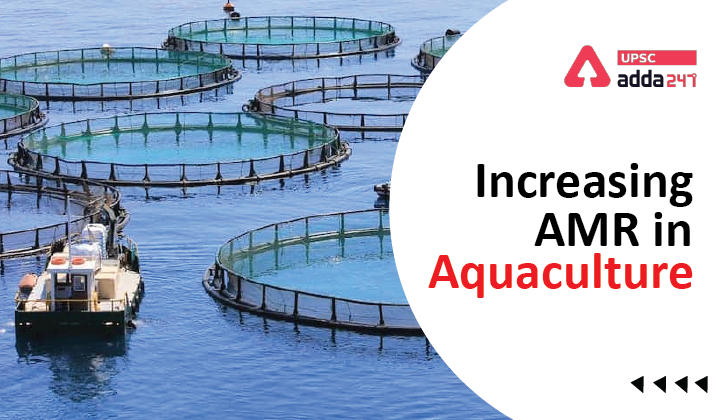Table of Contents
Increasing AMR in Aquaculture: Relevance
- GS 3: Conservation, environmental pollution and degradation, environmental impact assessment.
Anti microbial resistance in aquaculture: Context
- Recently, Ministry of Fisheries, Animal Husbandry & Dairying has alarmed all the States and UTs regarding the menace of continued use of antibiotics in the aquaculture sector despite issue of advisories against it.
Increasing AMR in Aquaculture: Key points
- The ministry said that sale of antibiotics in bulk quantities to the aquaculture farmers, especially shrimp aquaculture is a matter of serious concern.
- Indiscriminate use of antibiotics can pose serious health issues including development of antimicrobial resistance (AMR).
- The ministry has also informed that certain shrimp consignments from India has been rejected on account of detection of antibiotics.
- Further, the ministry has warned the states of probable hit in the export of shrimp leading to severe setback to the aquaculture industry, if the trend continuously.
Antibiotics in aquaculture: Suggested steps
- The Coastal Aquaculture Authority has already issued a list of antibiotics / pharmacologically active substances prohibited for use in shrimp aquaculture.
- The letter urged the chief secretaries to direct the state drug controllers to take action to monitor and regulate the sale and distribution of antibiotics for veterinary use, ensuring that antibiotics are only sold on the prescription of registered veterinary practitioners.
- The sale of the 20 substances should be completely banned from use in shrimp aquaculture. The sale of antibiotics in bulk to feed manufacturers and aquaculture farmers also should be strictly regulated and monitored.
What is Anti Microbial Resistance?
- Antimicrobial resistance (AMR) is the ability of microorganisms to persist or grow in the presence of drugs designed to inhibit or kill them.
- These drugs, called antimicrobials, are used to treat infectious diseases caused by microorganisms such as bacteria, fungi, viruses and protozoan parasites.
- Antimicrobial resistance (AMR) is a major global threat of increasing concern to human and animal health. It also has implications for food safety, food security and the economic wellbeing of millions of farming households.

Implication of AMR
- When microorganisms become resistant to antimicrobials, standard treatments are often ineffective, and in some cases, no drugs provide effective therapy. Consequently, treatments fail.
- This increases illness and mortality in humans, animals and plants.
- For agriculture, this causes production losses, damages livelihoods and jeopardizes food security.
- Moreover, AMR can spread among different hosts and the environment, and antimicrobial resistant microorganisms can contaminate the food chain.
Factors leading to increased use of antimicrobials in animal and plant production
- Burden of diseases that are otherwise preventable through modification of environmental hygiene, nutrition, husbandry and other management practices;
- Limited access to animal and plant health experts, as well as limitations in training and support for these experts;
- The use of antimicrobials as growth and production promoters in animals;
- Lack of regulation and oversight of the use of antimicrobial drugs;
- Over the counter or internet sales that make antimicrobial drugs readily available;
- Availability and use of substandard and falsified antimicrobials;
- Lack of awareness regarding good practices, leading to excessive or inappropriate use;
- Anthropological, sociocultural, political and economic factors that pose barriers good practices.
Antibiotics in aquaculture
- Emergence of antimicrobial resistance (AMR) in cultured fishes is one of the major challenges faced in aquaculture.
- The high prevalence of bacterial infections in fishes leads to frequent use of antibiotics by the fish-farmers and this leads to their persistence in the aquatic environment. This in turn results in the increase in the antibiotic resistant bacteria.
- Most of the cultured fishes, including ornamental fishes, possess diverse pathogens that exhibit multiple antibiotic resistance.
- Suggested measures: Continuous monitoring programmes, timely detections of the resistant bacteria and implementation of proper regulations are necessary to curb the dissemination of anti-microbial resistance in aquaculture.
Also Read:




 TSPSC Group 1 Question Paper 2024, Downl...
TSPSC Group 1 Question Paper 2024, Downl...
 TSPSC Group 1 Answer key 2024 Out, Downl...
TSPSC Group 1 Answer key 2024 Out, Downl...
 UPSC Prelims 2024 Question Paper, Downlo...
UPSC Prelims 2024 Question Paper, Downlo...




